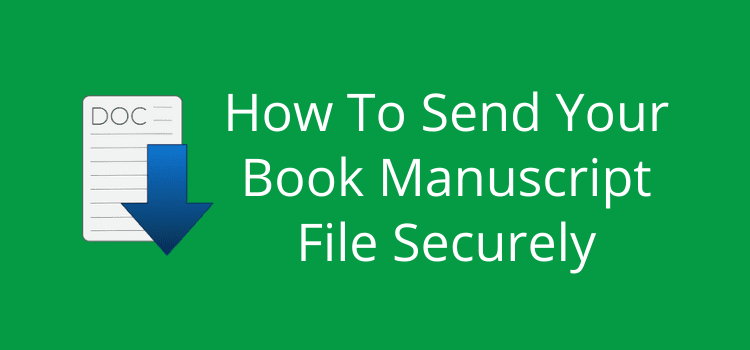
All authors need to share a book manuscript file before publishing a book.
You might need to send a copy to your editor, proofreader, or beta readers or a submission to a publisher or literary agent.
But you need to be aware that sending your precious manuscript as an email attachment is an unsafe way to do it.
Email is insecure, making it easy for unscrupulous actors to steal your manuscript.
Manuscript theft is a danger
Many authors have fallen prey to manuscript theft. The New York Times reported on a phishing scam that resulted in stealing unpublished book manuscripts.
The BBC wrote an article about the arrest of a person connected with trying to steal a manuscript from Margaret Atwood.
Another article appeared in Vulture, again related to attempts to steal a manuscript.
These cases relate to high-profile authors. But the dangers of possible theft when you share a book manuscript online apply to all authors.
There are many different types of Kindle scams, with manuscript theft being one of them. It only takes a few minutes for a fraudster to change the author name on your manuscript and then publish it online.
Once it’s published, you lose all your rights to your book. You could take legal action. But in most cases, you would be wasting your time and money if the thief is in another country.
This is why you should take extra care when you need to share your manuscript with anyone.
Always make sure that you send your manuscript using the safest and most secure methods.
You also need to be 100% certain that the person you are sending the file to is responsible and will not share or forward your file to anyone.
Where possible, you should avoid using email. But if you have no choice, be extra vigilant and take precautions.
Watch out for phishing emails

Receiving an unexpected email from a publisher or agent requesting your manuscript for review is very tempting for a new author.
But if you have never heard of the publisher or agent before, beware.
There’s always the possibility that it could be a phishing scam.
Learning how to recognize phishing emails is not difficult. But you need to be on your guard at all times.
Security Metrics has a terrific blog post about the seven signs you should check to avoid falling for a phishing email.
If you don’t know a person sending you an email, never share your book manuscript until you check. Make sure the person is on the level.
How to protect your manuscript
You always need to use good file management with your manuscript.
Always have backups, and never send your master file.
Whenever you need to share your manuscript, create a copy and rename it appropriately before sending it.
Another excellent idea is to add password protection to your file. You can do this with almost any word processor.
Then when you share your file, you can send the password separately by SMS or email.
Safer ways to share a book manuscript

Email is the quickest and easiest way.
But it’s not secure, and it’s so easy to make a mistake and send it to the wrong email address.
One of the biggest traps is using the reply, or worse, the reply-all function. If you do this, any number of people could receive your attachment.
The safest way with email is to prepare a new message with only one email address. Also, if you password-protect the file, you will reduce your risk enormously.
Another way is to share your file using cloud services such as Dropbox or Google Drive.
It’s slightly safer than email if you set secure sharing options.
But the best way to protect yourself is to use a secure file transfer service.
There are many services available, both free and paid. You only need to do a Google search to find lots of choices.
I use SwissTransfer, a free secure service for all my file transfers, and it works perfectly.
However, you still need to trust your recipients, whichever means you use.
Don’t trust anyone you don’t know
You can take all the precautions when preparing your manuscript file for sharing.
But the critical factor is knowing and trusting the person.
You probably know your editor or beta readers well, so you can be quite confident.
However, take extra care when you are asked or tempted to share your book manuscript with anyone else.
Make sure you do your checks to ensure the person is honest and trustworthy.
Lastly, never send your file to multiple recipients.
If you have to send it to two people, always send each one separately.
Summary
It takes a very long time to write a book. Yet it takes only a few minutes to steal all your hard work.
Ebook and book piracy is a nuisance, but manuscript theft has much more serious consequences.
The bottom line is that you should never share your book manuscript unless it is absolutely necessary.
And even then, only share it safely and securely with people that you know you can trust 100%.
Related reading: How To Find And View Page Count In Apple Pages For Mac




Sending your manuscript by secure download is safer than an email attachment. But if you don’t know the person you are dealing with, you will have to trust that they do the right thing. Transferring separate chapters won’t make any difference.
Mr. Haines, I am in a dilemma. I just completed 7 out of 8 chapters of my e-book and am about to send the manuscript to a proof-reader and editor via Fiverr. I am in America and the editor is in South East Asia. I want to make sure I am doing this safely. And after reading your post, I don’t know if it is safer to send the whole manuscript or should I just send one chapter at a time? I don’t know the person but they’re registered with Fiverr service. Any advice or guidance will be appreciated.